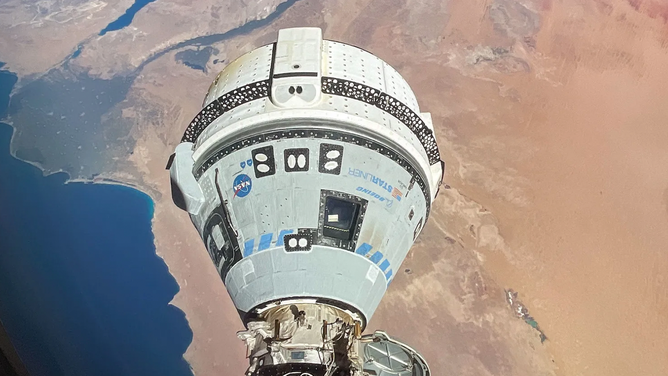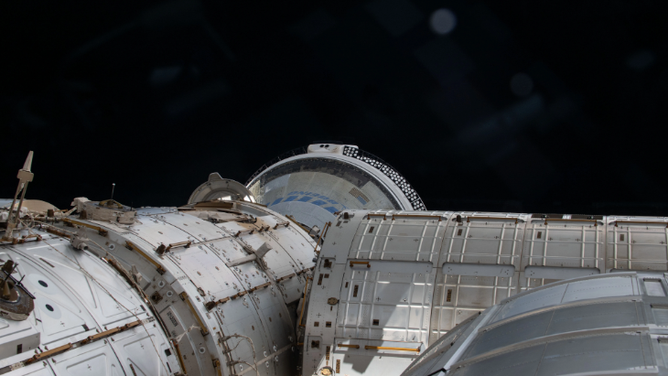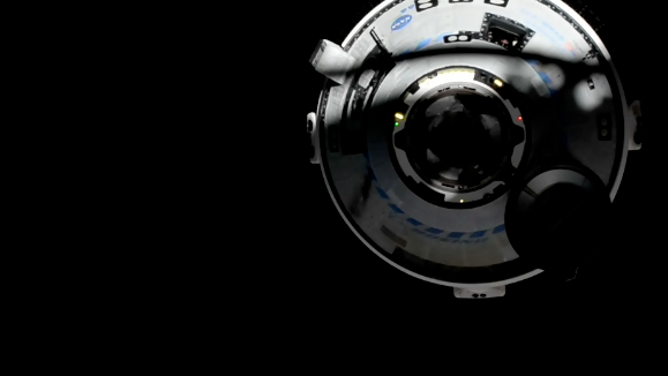Stranded astronauts won't return from space station on Boeing’s Starliner spacecraft, NASA admits
Despite issues with helium leaks and thrusters, Boeing has long maintained its spacecraft. To avoid the risk of failure, NASA will bring Wilmore and Williams home on a future SpaceX mission.
Boeing Starliner launches 2 NASA astronauts into orbit for first time
ULA's Atlas V rocket launched on Wednesday morning from Florida sending the first Boeing Starliner capsule with crew into orbit. NASA Astronauts Butch Wilmore and Suni Williams are conducting the crew flight test of Starliner and will spend about a week at the International Space Station.
HOUSTON – NASA announced Saturday that a test flight, initially expected to last just over a week, will conclude with Boeing’s Starliner spacecraft returning home without astronauts. Instead, a replacement vehicle will be sent to the International Space Station to bring Butch Wilmore and Suni Williams back to Earth.
The pair originally lifted off from Florida’s Space Coast in early June but while in orbit and docked to the ISS, engineers discovered helium leaks and issues involving thrusters, which prompted NASA and Boeing to investigate.
The investigation included ground tests at the Army’s White Sands Missile Range in New Mexico to recreate the problems, which both NASA and Boeing characterized as minor.
NASA management even went as far as saying it would use the spacecraft in the event of an emergency, but analysis in the weeks since has undermined stakeholders' assurances that the vehicle is a viable option to use in the astronauts' return home.

NASA astronauts Butch Wilmore, left, and Suni Williams, wearing Boeing spacesuits, are seen as they prepare to depart the Neil A. Armstrong Operations and Checkout Building for Launch Complex 41 on Cape Canaveral Space Force Station to board the Boeing CST-100 Starliner spacecraft for the Crew Flight Test launch, Wednesday, June 5, 2024, at NASA’s Kennedy Space Center in Florida. Photo Credit: (NASA/Joel Kowsky)
(NASA)
SEE THE OBJECTS HUMANS LEFT BEHIND ON THE MOON
Due to uncertainties surrounding the spacecraft, NASA announced that Wilmore and Williams will return to Earth on a future SpaceX mission.
"Spaceflight is risky, even at its safest and most routine. A test flight, by nature, is neither safe nor routine. Our decision to keep Butch and Suni aboard the Space Station and bring Starliner home uncrewed is the result of our commitment to safety: our core value," NASA Administrator Bill Nelson stated.
These changes in itinerary mean that the composition of SpaceX Crew 9 will need to be altered, and a liftoff from Florida’s Space Coast will likely not happen before September.
Under the revised plan, what was expected to be a crew of four could be reduced to make room for the two stranded astronauts aboard the ISS, who are expected to return in February 2025.
Until their departure, Wilmore and Williams will continue to perform experiments aboard the space station while they await additional supplies and custom suits for their ride back to Earth.
ASTRONAUTS WAITING ON RIDE BACK TO EARTH COULD RETURN ON SPACEX SPACECRAFT, NASA SAYS
What is the future of the Boeing Starliner program?
Even in light of the issues, NASA Commercial Crew Program Manager Steve Stich recently stated he saw a "bright future for Starliner," but it remains to be seen whether the spacecraft will fly again.
The Boeing program has seen years of delays and has faced losses of more than a billion dollars, according to filings with the U.S. Securities and Exchange Commission.
The news surrounding the Starliner comes at a time in which the Fortune 500 company was attempting to turn around turbulent years that featured the admittance of design flaws with its 737 MAX, a door plug that flew off an aircraft mid-flight, the shakeup of top management including its CEO and whistleblowers alerting investigators to manufacturing practices at some of its facilities.
For its part, NASA has maintained its desire for at least two U.S.-based vehicles capable of transporting astronauts to the ISS, as only one has existed since 2020.
SEE RENDERINGS OF SPACE STATION TO BE BUILT AROUND THE MOON
A successful launch and landing of the Boeing CST-100 Starliner would likely have paved the way for the spacecraft to become the second certified vehicle for transporting crews and supplies to the ISS.
Behind the scenes, NASA and Boeing were already preparing for the first post-certification mission, which was expected to launch four astronauts to the ISS in August 2025- a date and a mission that both now appear to be in jeopardy.
NASA management said it was too early to determine how future Starliner flights would be impacted, as a review of the spacecraft's flightworthiness is likely to take several months.
While at least two other private U.S. space companies have expressed interest in conducting crewed missions to the ISS, Elon Musk's Dragon spacecraft is currently the only certified vehicle capable of NASA operations.




